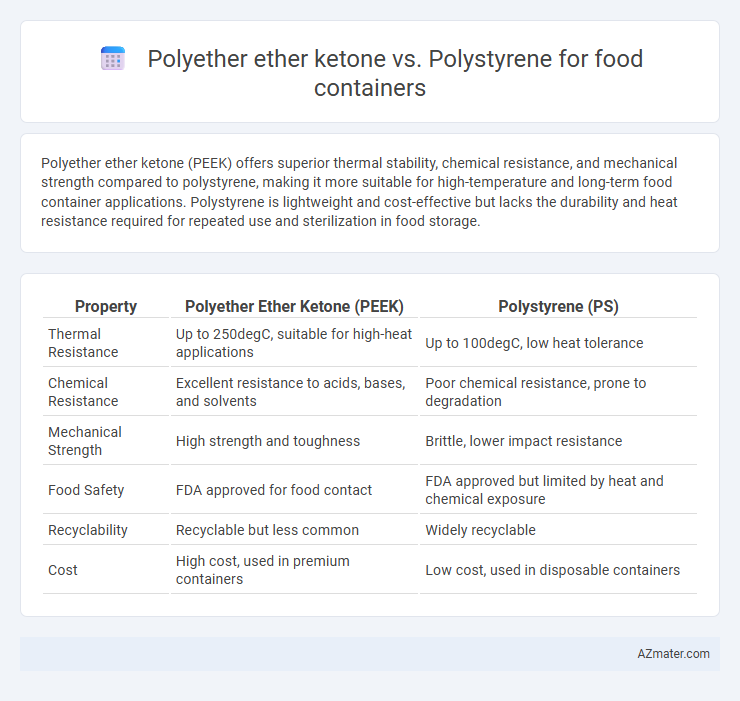Polyether ether ketone (PEEK) offers superior thermal stability, chemical resistance, and mechanical strength compared to polystyrene, making it more suitable for high-temperature and long-term food container applications. Polystyrene is lightweight and cost-effective but lacks the durability and heat resistance required for repeated use and sterilization in food storage.
Table of Comparison
| Property | Polyether Ether Ketone (PEEK) | Polystyrene (PS) |
|---|---|---|
| Thermal Resistance | Up to 250degC, suitable for high-heat applications | Up to 100degC, low heat tolerance |
| Chemical Resistance | Excellent resistance to acids, bases, and solvents | Poor chemical resistance, prone to degradation |
| Mechanical Strength | High strength and toughness | Brittle, lower impact resistance |
| Food Safety | FDA approved for food contact | FDA approved but limited by heat and chemical exposure |
| Recyclability | Recyclable but less common | Widely recyclable |
| Cost | High cost, used in premium containers | Low cost, used in disposable containers |
Introduction to Food Container Materials
Polyether ether ketone (PEEK) and polystyrene (PS) represent two distinct categories of materials used in food container manufacturing, each offering unique properties. PEEK provides exceptional chemical resistance, high thermal stability, and mechanical strength, making it suitable for applications requiring repeated sterilization and durability. Polystyrene, commonly utilized for disposable food containers, delivers cost-effectiveness and ease of molding but lacks the thermal resistance and mechanical robustness found in PEEK.
Overview of Polyether Ether Ketone (PEEK)
Polyether Ether Ketone (PEEK) is a high-performance thermoplastic known for its exceptional chemical resistance, thermal stability up to 250degC, and mechanical strength, making it suitable for advanced food container applications requiring durability and safety. Unlike Polystyrene, PEEK is highly resistant to moisture, solvents, and harsh cleaning agents, ensuring food containers maintain integrity without leaching harmful substances. Its biocompatibility and compliance with stringent food contact regulations position PEEK as a premium material for reusable, long-lasting food containers in demanding environments.
Overview of Polystyrene (PS)
Polystyrene (PS) is a versatile thermoplastic polymer widely used in food containers due to its clarity, lightweight nature, and cost-effectiveness. It offers excellent insulation properties and is commonly found in disposable cups, cutlery, and food packaging trays. However, PS has limited heat resistance and is less durable compared to high-performance polymers like Polyether ether ketone (PEEK), making it less suitable for applications requiring repeated use or high-temperature stability.
Mechanical Strength Comparison
Polyether ether ketone (PEEK) exhibits superior mechanical strength compared to polystyrene (PS), with tensile strength values typically exceeding 90 MPa versus PS's approximate 40 MPa. PEEK's high modulus of elasticity, around 3.6 GPa, enhances its impact resistance and rigidity, making it ideal for durable food containers subjected to mechanical stress. In contrast, polystyrene's lower mechanical robustness limits its use to disposable or low-stress applications where flexibility and lightweight are prioritized over durability.
Thermal Resistance and Temperature Stability
Polyether ether ketone (PEEK) exhibits superior thermal resistance and temperature stability compared to polystyrene, maintaining structural integrity at continuous use temperatures up to 250degC, while polystyrene typically deforms above 80degC. PEEK's high glass transition temperature and excellent chemical resistance make it ideal for food containers requiring sterilization and repeated heating. Polystyrene, being more prone to thermal degradation and deformation, is better suited for single-use or cold food packaging.
Chemical Resistance and Food Safety
Polyether ether ketone (PEEK) offers superior chemical resistance compared to polystyrene, with excellent stability against acids, bases, and solvents commonly encountered in food packaging. Its high thermal stability and inert nature minimize the risk of chemical leaching, ensuring enhanced food safety and compliance with FDA regulations. Polystyrene, while cost-effective, is more susceptible to chemical degradation and migration of styrene monomers, posing greater risks for food contamination under prolonged exposure to heat or acidic foods.
Durability and Reusability
Polyether ether ketone (PEEK) exhibits superior durability compared to polystyrene (PS), with exceptional resistance to heat, chemicals, and mechanical stress, making it ideal for long-term food container use. PEEK's high reusability stems from its ability to withstand repeated sterilization cycles without degradation, whereas polystyrene often becomes brittle and deforms under similar conditions. Selecting PEEK for food containers significantly enhances lifespan and safety, particularly in environments demanding frequent cleaning and temperature variation.
Environmental Impact and Sustainability
Polyether ether ketone (PEEK) offers superior environmental benefits over polystyrene (PS) in food container applications due to its exceptional chemical resistance and high thermal stability, enabling longer product lifecycles and reduced waste generation. Unlike polystyrene, which is largely non-biodegradable and contributes significantly to microplastic pollution and landfill accumulation, PEEK is more amenable to recycling and can withstand multiple sterilization cycles without degradation. The sustainability profile of PEEK is further enhanced by its potential for bio-based sourcing and lower overall environmental footprint during manufacturing compared to the petroleum-derived polystyrene.
Cost Analysis and Market Availability
Polyether ether ketone (PEEK) offers superior chemical resistance and thermal stability for food containers but comes at a significantly higher cost, often priced five to ten times more than polystyrene (PS). Polystyrene dominates market availability due to its low production cost and ease of molding, making it the preferred choice for disposable food packaging despite its lower durability and heat resistance. The cost-benefit analysis favors polystyrene in high-volume, low-cost applications, whereas PEEK is reserved for specialized containers requiring enhanced performance and longevity.
Choosing the Best Material for Food Containers
Polyether ether ketone (PEEK) offers superior chemical resistance, high thermal stability up to 250degC, and excellent mechanical strength, making it ideal for reusable food containers that require durability and safety. Polystyrene (PS), while cost-effective and lightweight, has limited heat resistance and can release harmful substances when exposed to high temperatures, limiting its suitability for hot food storage. Choosing PEEK over polystyrene ensures longer-lasting, safer, and more sustainable food containers capable of withstanding frequent use and cleaning cycles.

Infographic: Polyether ether ketone vs Polystyrene for Food container
 azmater.com
azmater.com